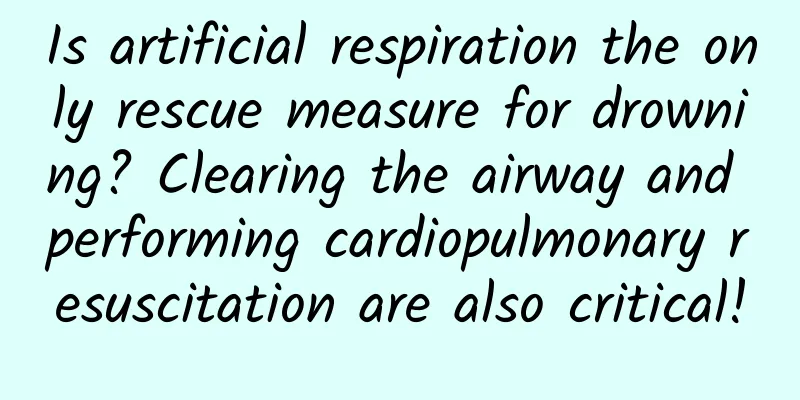Is artificial respiration the only rescue measure for drowning? Clearing the airway and performing cardiopulmonary resuscitation are also critical!

|
Tuchong Creative During the summer vacation, refreshing water recreation such as swimming and surfing have become the first choice for many families. However, safety when playing in the water is also a special concern for many parents. Whether they can swim or not, children and even adults may encounter emergencies, so amusement parks with water activities are generally equipped with professional rescue staff. However, there are many places where water play does not have such conditions. Therefore, every summer vacation, there are always news related to drowning that frequently rushes to the hot search. Therefore, the corresponding first aid knowledge is very worthy of popularization! Once you encounter a water loss accident, how should you implement first aid? Let's talk about it today. 01 “Water suffocation” is the leading cause of death from drowning Drowning progresses very quickly, and the cause of death is usually "water suffocation". The water inhaled into the lungs, as well as mud and weeds at the scene or personal vomit, quickly blocks the respiratory tract, blocking the normal intake of oxygen. The blood circulation in the body is not carried by oxygen, and carbon dioxide waste gas cannot be discharged, so breathing stops. Soon the heart stops beating and the circulation is interrupted. Life is in danger. Tuchong Creative Another less common drowning situation occurs when swimming or diving, when the body is suddenly stimulated by cold water, which reflexively causes laryngeal spasm. At this time, although the person does not inhale a large amount of water, the local spasm closes the respiratory tract, preventing air from entering or exiting, and soon causes respiratory arrest, followed by interruption of blood circulation. As we all know, breathing and heartbeat are the most important physiological activities of life. Under normal circumstances, breathing brings oxygen into the alveoli through the trachea, and then enters the blood circulation. The oxygenated blood is transported to the heart, brain tissue and all parts of the body. The body's demand for oxygen is very high and also extremely demanding. There is no oxygen "warehouse" in our human body, so once the supply of oxygenated blood is interrupted, the remaining oxygen in the brain tissue is only enough for 10 seconds, and the remaining oxygen in the heart is only enough for a dozen contractions. The brain tissue's demand for oxygen is very urgent. If the brain tissue is deprived of oxygen for more than 6 minutes at room temperature, the brain cells will be irreversibly damaged. Therefore, we have repeatedly emphasized that rescue must race against time, time is life! Tuchong Creative 02 First aid steps Empty the upper airway first For sudden death caused by drowning and respiratory and cardiac arrest, cardiopulmonary resuscitation (CPR) should be used as soon as possible for first aid. However, since the upper respiratory tract is blocked by water, mud, weeds, and vomit, the first aid effect will be greatly reduced if CPR is performed without regard to whether the respiratory tract is unobstructed. Therefore, when performing mouth-to-mouth breathing during cardiopulmonary resuscitation, it is necessary to ensure that the airway is unobstructed, and the first step of drowning first aid - "emptying the respiratory tract" must be completed first. Tuchong Creative The specific method is to use the head-down, foot-high position to pour out the water in the body. The simplest method is for the rescuer to kneel on one leg and bend the other leg, put the waist of the drowning person on his knee, let the head hang down, and then press the waist and back. You can also use the natural slope on the ground to put the head in a downhill position. Using small wooden stools, large stones, etc. as padding can also achieve a similar effect. But we must remind you that the purpose of these practices is definitely not to completely empty the water, but to clear the airway and clear obstacles for CPR. Therefore, after quickly controlling the water and clearing the airway, you should immediately perform cardiopulmonary resuscitation (CPR) with mouth-to-mouth breathing and heart compression. If you control the water just for the sake of controlling the water and do not start CPR in time, you will miss the golden opportunity for rescue. Especially for children, CPR should be started quickly. 03 Artificial respiration and cardiopulmonary resuscitation Restore breathing and heart rate After the water control work is completed, the next task is to restore the heartbeat and spontaneous breathing. We often see "artificial respiration" in movies and TV dramas, so what are the specific steps? Mouth-to-mouth artificial respiration is to use artificial methods to help drowning people breathe and achieve the purpose of gas exchange. Before mouth-to-mouth breathing, the airway must be opened first. This is an important first step to maintain the patency of the airway and the guarantee of free flow of gas, which is especially important for drowning people. First, the debris in the mouth must be quickly cleaned up, and then the drowning person is asked to keep the head tilted back, such as tilting the head back and lifting the chin, lifting the neck and pressing the forehead. The purpose of this is to make the throat and airway on the same horizontal line, making it easier to blow air into the lungs. The specific method of blowing is: pinch the nostrils of the drowning person, cover the mouth of the drowning person with your lips, the rescuer takes a deep breath, blows into the drowning person's mouth, and observes the chest of the drowning person bulge. After each blow, release the hand pinching the nostrils to let the air out, and observe the raised chest of the drowning person fall back; then the rescuer turns his head to the side, inhales fresh air, and blows a second time. You can also blow into the nostrils of the drowning person, that is, blow from mouth to nose. If the chest does not bulge after blowing, it may be that the blowing force is too small or the respiratory tract is blocked, and corresponding measures should be taken to correct it. Tuchong Creative When blowing, you can cover the lips with a piece of clean gauze before blowing. If conditions permit, you can use a simple breathing mask, a mouth-to-mouth breathing mask, or an S-shaped ventilation tube to avoid direct contact with it. While performing artificial respiration, you should also immediately perform chest compressions, blowing two breaths each time and performing 30 chest compressions. The two sets of emergency actions should be repeated, regular, and coordinated. One thing to note here is that when performing chest compressions, the drowning person should lie on his back on a flat surface, and must "lean his back against a hard surface." Some rescuers, eager to save the patient, often place the patient on a spring bed, a coir bed, or a sofa, and perform chest compressions with the patient "on a soft surface," which can seriously affect the effectiveness of the rescue. The specific method is: put the middle finger of the hand to the depression below the neck of the drowning person (equivalent to the Tiantu acupoint), put the palm on the middle of the chest, and the base of the palm is just below the 1/2 of the sternum (i.e. the middle of the line connecting the two nipples), and press the other hand on this hand, overlap the base of the two palms and interlock the fingers, lift the five fingers of both hands away from the chest wall, straighten the arms vertically and press rhythmically, so that the chest sinks 5 to 6 cm, then relax, repeat, about 100 times per minute. The rescuer can adjust the position according to the situation and choose to press on the front or side for first aid, but the position of the base of the palm must not be wrong. Tuchong Creative It should be noted that when pressing, do not use the entire palm to apply pressure, but rather the base of the palm, and limit it to the lower 1/2 of the sternum. The range should not be too large to avoid breaking the ribs, puncturing the heart and lungs, or expanding to the liver and spleen to cause rupture injury. When external chest compression is effective, the carotid artery pulsation can be felt and appears in rhythm with the compression. If the breathing and heartbeat of the drowning person have recovered, it indicates that cardiopulmonary resuscitation is successful and rescue can be stopped. When performing cardiac compression on infants, the rescuer only needs to use one hand, and the compression site is the same as that for adults, and the force should be moderately reduced. If there is an external defibrillator (AED) at the rescue scene, it can be used as soon as possible, which will greatly increase the chance of survival of the drowning person. 04 Do the work in advance First aid equipment and professionals are indispensable In fact, in addition to swimming pools, other common drowning sites include outdoor natural bathing areas such as rivers, lakes, and seas. Floods caused by heavy rains are also a major cause of drowning in summer. In this regard, different venues must prepare corresponding emergency plans and related work. When a large amount of water accumulates rapidly in a public place, which may cause accidents such as pedestrian drowning, the competent department should make plans for possible drowning, set up temporary rescue stations, and staff them with professional doctors and nurses, or first aid personnel trained in cardiopulmonary resuscitation and defibrillation. At the same time, continuous inspections should be carried out, and once a drowning person is found, he or she should be quickly moved to a safe place for first aid. Tuchong Creative Because the mouth, nose and upper respiratory tract of the drowning person must be kept clear, temporary first aid stations should be equipped with professional equipment such as laryngoscopes and endotracheal tubes. Adequate simple breathing masks should be prepared at ordinary times so that mouth-to-mouth breathing can be carried out effectively and safely. Fixed first aid stations should be set up in swimming places, and rounds should be conducted. In addition to setting up first aid stations, swimming pools that use natural environments such as rivers, lakes, and seas should also set up lookouts in places with wide fields of vision to promptly detect whether drowning has occurred on the water surface so that quick action can be taken. Author | Li Zonghao, President of the Chinese Medical Rescue Association, Editor-in-Chief of the Chinese Journal of Emergency Resuscitation and Disaster Medicine, Chief Physician, Professor, Doctoral Supervisor Review | Wang Qian, Chief Physician, Emergency Department, Third Medical Center, PLA General Hospital |
>>: [Creative Cultivation Program] Why does the promised rainstorm never come?
Recommend
LeTV Sports is going out of business after losing its core copyright
The lack of follow-up funds has broken down LeTV ...
14 kinds of horrible and weird therapies, guess what diseases they are treating?
Modern medicine has come a long way from leeches ...
Android source code: Get a list of cities across the country similar to contact sorting
Functional classification: Tools Supported platfo...
How to reduce APP uninstall rate? Here are seven ways!
The mobile application market is now a crowded ma...
TCL faces huge transformation pressure, with many executives leaving
TCL Group, which has just released its semi-annua...
The latest Google Admob channel promotion strategy in 2015
According to statistics, taking Android as an exam...
Tik Tok monetization, how to become a "profitable" vlog blogger?
Tik Tok has been around for four years now, and t...
Outsourcing order-taking platform, where can SEOs take outsourcing work?
SEO is a profession and also a job. The purpose o...
Internet mobile phone market: two times of irrational prosperity
Recently, an article talked about Xiaomi's su...
The role of KOL marketing in brand operation and promotion!
What is a KOL? KOL: Key Opinion Leader (KOL for s...
40 private domain tips from 0 to 1!
During this period, we have been providing privat...
Baise Moving Mini Program investment price inquiry, how much is the Baise Moving Mini Program investment price?
What is the investment cost of Baise Moving Mini ...
If the preservative sodium dehydroacetate is added to bread, it becomes "poisonous bread" and will eating it damage the liver and kidneys?
gossip "Bread and other baked goods add the ...
iOS 7.1.1 surprise new changes: exciting
In addition to fixing bugs and Touch ID, iOS 7.1.1...
Breaking the world record! China's "artificial sun" has achieved a major breakthrough!
The "artificial sun", also known as the...









